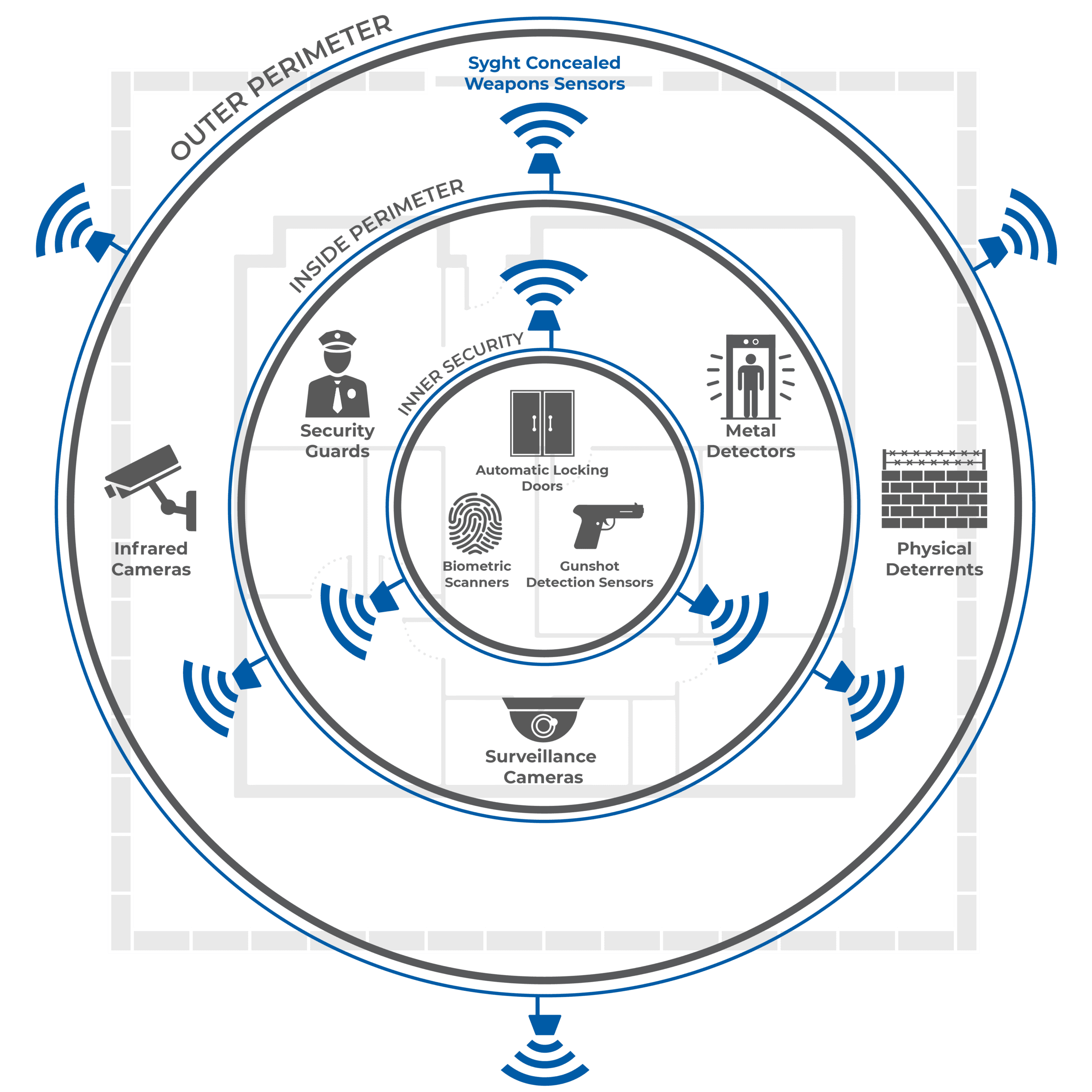How Can “Layered Security” Protect Us From Today’s Threats?
Around the world, the intensity of terrorism is increasing as its impact spreads to more countries. Over 60 countries have experienced at least one fatal attack from terrorism in every year since 2012, and 2019 is on track to be one of the U.S.’s most deadly years for mass shootings.
With public and private places increasingly becoming targets for bombings, mass shootings and other tragic attacks, detecting and mitigating potential threats in real time is essential to securing public safety. From shootings at Sandy Hook and Las Vegas to the bombings at Brussels Airport and Manchester Arena, attacks are increasingly occurring on soft targets where concealed weapon detection isn’t deployed.
Think about the tens millions of people streaming into football stadiums, concerts, hotels and airports each week. All of these venues require a robust system of different security measures to ensure the protection of people and other valuable assets. Have you ever wondered what security measures — active or passive — are put into place to ensure your safety?
What Is Layered Security?
In order to protect against a potential threat, the U.S. military establishes perimeter defenses through a concept known as “layered security,” or erecting multiple layers of security control. Layered security starts at the far edge of a security perimeter and works its way in, and as more layers of protection are put in place, the probability of active threats decreases. In layered security, a series of different defenses are utilized to cover the gaps in the protective capabilities of other layers.
The outer perimeter, or the area from the property line to front entrance security, is essential in layered security. When securing the outer perimeter, the goal is to control access to your property. Inside the perimeter, the next line of defense is entrance security, which aims to prevent firearms or other concealed weapons from making it past the entrance to your building. Beyond the entrance, inner security focuses on limiting access inside the building with key cards and other restrictions.
From its military origins, layered security has taken a more expansive definition to include low-tech approaches, such as gates, locks, alarms, metal detectors, up to the latest innovations in AI and facial recognition software that enables video surveillance. Today’s security professionals need a full arsenal of solutions working together because each different measure works to fill gaps in other layers, ultimately increasing the probability of stopping a threat.
It’s important to note that existing security implements like barriers and video surveillance, while still effective, are increasingly giving way to more high-tech approaches, including lidar tracking, infrared video surveillance, AI, facial recognition and the concealed weapon detection sensors we’re developing at Syght.
Pat-downs and metal detectors create bottlenecks, so they are increasingly being replaced by high-throughput portals and optical turnstiles equipped with sensors while the inner layer’s key cards are going away in favor of chemical sensors, biometric door access with lidar sensors to prevent tailgating, gun-shot detection sensors and networked doors that automatically lock when threats are detected at the entrance or perimeter layer.
With recent advances in threat detection technology, layered security has become a highly effective and increasingly affordable measure for companies, schools, arenas, airports and other high-traffic venues.
Faster Detection = Improved Protection
The earlier a threat can be detected, the probability of preventing that threat from causing harm increases significantly. While any single defense may be flawed, each different layer ideally offers space and time for potential threats to be countered and mitigated. Syght is pushing the perimeter of physical locations out further in order to allow more time for countermeasures to be taken and to stop threats before they become real issues.
Our stand-off concealed weapon detection sensors are able to scan large, open spaces, delivering video-rate quality imagery with high enough resolution to detect potential threats up to 30 meters away, or enough distance to ameliorate the threat. And because of the extremely high frequency of the wavelengths, our security solution can see through obscurants, such as clothing, fog, dust and smoke to identify potential threats. The sensor can even be installed in covert locations like behind a sheet of dry wall, for example.
Even in high traffic areas, Syght sensors facilitate continuous traffic flow and mitigate waiting in lines by allowing people to walk through security without stopping. With Syght, individuals don’t need to remove contents from their pockets and pass through portals to be scanned for concealed weapons. Even better, the discrete nature of our sensors mean visual cues of security aren’t everywhere surrounding a venue — people might not even know it’s there because it’s not a formal security portal they’re walking through. Best of all, our state-of-the-art security solution is 100% safe and does not emit any radiation onto the subjects in the area being scanned.
On a sunny day in October in Las Vegas two years ago, a gunman opened fire from his 32nd floor room on a crowd of people at a country music festival, killing 58 and injuring hundreds. The gunman exploited known and unknown gaps in security, and the result is one of the largest mass shootings in our history (at the time of this writing, that is). When it comes to protecting people and other valuable assets, a layered approach to security enables earlier detection, and that can help save more lives.


